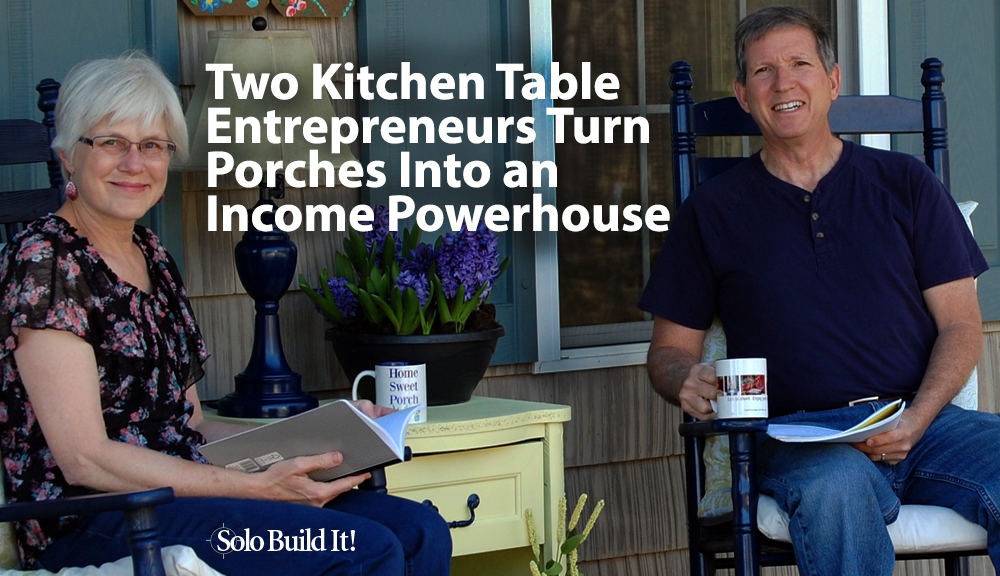
The best part for us is what we don’t have: no alarm clocks, no commutes, no bosses, no asking for vacation time, no appraisals, and no set hours.Mary and Dave from front-porch-ideas-and-more.com
Mary and Dave started their online business from their kitchen table. To this day, they remember the date when they made their first 77 cents from their business: April 20th, 2009.
A month later, their daily income was 10 times that, and growing fast. Within 18 months, Mary was able to quit her day job. She and her husband have earned their living from their online business ever since.
Was it easy? No. Being a entrepreneur couple requires dedication and a ton of consistent effort, says Mary. But in the end, it’s so worth it!
In their story, you’ll hear…
- How they know what to write about
- How they publish and market their eBooks
- How they monetize with a dozen income streams
- What their biggest challenges are and
- What they enjoy most about being solopreneurs.
But first… why porches?
1. Mary and Dave, you are known as the “Kitchen Table Entrepreneurs.” How did this come about? And why did you choose porches as your niche?
I think we dubbed ourselves “kitchen table entrepreneurs” early on because we worked from our kitchen table in the first 5-6 years of our business. Sometimes, we still go back to our kitchen table today.
Our niche — porches — was not our first idea. In fact, the two of us knew we wanted to build our business together so we each wrote a list of topics we’d enjoy writing about. Dave had fly fishing, hiking and woodworking on his list. I had grandchildren, making gifts and sewing quilts on mine. But none of these topics were something we both enjoyed. Then our minds drifted to travel, but that wasn’t it, either.
So one day, a few weeks into exploring and analyzing topics, a big flash of inspiration hit us. We both like porches and often turn our heads when traveling through neighborhoods to admire the porches. Dave grew up with a big porch and I remember my grandma’s house having a big front porch with a swing.
But we had no idea whether that would be a good business choice. So, we used SBI’s keyword tool to research the topics of porches and porch related things like swings, rocking chairs, porch construction and curb appeal. Granted we used SBI’s tools to research other niches as well, but this was the first one that really struck a chord with both of us.
If you are having trouble coming up with a niche on your own, SBI! provides a tool (“Seed Generator”) that helps you do that, totally based on what you know. When you have your list, narrow the topics down to your top 3; then research these top choices further. Like Mary and Dave explained, you want to find out if your ideas have business potential. That’s where SBI!’s Brainstorm It! tool comes in. Brainstorm It! brings back hundreds of keywords (aka “topics”) related to your niche concept. For each keyword, it tells you how many people search for it (demand) and how much competition there is (real supply). With smart filter and analysis functions, Brainstorm It! helps you decide if your business niche is too broad, too narrow or just right. It considers several factors, including how much time you plan to invest in your business.
After having run keyword searches, we were happy with the data we found on our topic, although admittedly it wasn’t a big “Wow.” Yet, the numbers seemed plausible to us, based upon the guidelines in the Action Guide, so we committed to it and haven’t looked back.
And might I add that when we started www.front-porch-ideas-and-more.com in late 2008 we had no pictures of porches, nor did our house (at that time) even have a porch. Plus it was in the middle of winter. We were not exactly against all odds, but you get the idea.
In the first 18 months, we worked super hard to get our business going. I still had my day job and so we burned the midnight oil writing content. We first began earning money about 4-5 months into it — in fact we earned 77 cents on our first day of monetizing (April 20, 2009).
Mary and Dave demonstrate the key requirements of building a profitable online business: Brains (knowledge and, ideally, passion about your chosen subject), Attitude (an optimistic outlook which keeps you moving forward even when sometimes things seem overwhelming) and Motivation (knowing that bumps along the way will happen, and treating them with dogged perseverance). Read more on BAM 💥 here. Holding down a day job while building an online business is not a cake-walk. But the satisfaction of seeing your first earnings — no matter how small — makes it all worthwhile.
If we could make 77 cents, we could make more. Sure enough, a month later the income was over 10 times that. $8 doesn’t sound like much, but once we knew how to grow income, we knew we’d be fine.
Within 18 months I was able to quit my day job. The two of us have earned our living from our online business ever since then. That still amazes us both!
We have experienced highs and lows along the way, but it’s all been well worth it.
You continue with renewed energy and focus until the day comes when you quit your day job (if this was your goal).
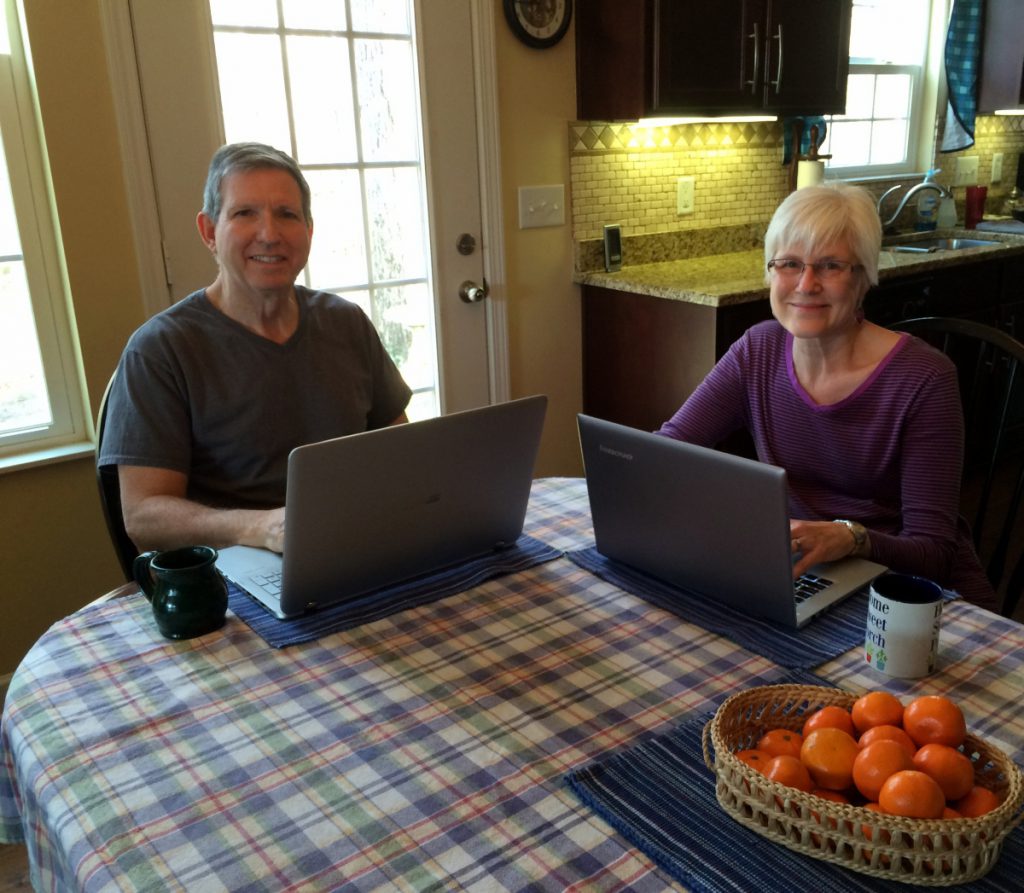
2. Tell us about your philosophy regarding content. How do you know what your prospective customers are looking for? Where does this information come from?
There are many micro-niche topics (within the realm of porches) to write about. Plenty of them. In the beginning, many people looked at us with a quizzical look, wondering how much could there be to say about a porch. At first glance, it might seem that our niche would be rather limited on what we could write about. After all, it’s just a porch.
But we realized early on that there is an abundant realm of topics to cover. We used SBI’s Brainstorm It! tool to help us decide what we would write about — and we continue to do so to this day.
We started with our keyword research and then laid it out in categories and “tiers” (how our site would be structured) on a very large sheet of paper that we hung on our wall.
Now that we’ve covered most of the nuts and bolts of porches, we also look at trends and write about related topics that align with porches. We’ll never run out of content ideas to write about for our site.
Our content comes from…
- our experiences with our own porch (yes, we now have a nice wraparound porch on our cottage-style home)
- ideas we’ve seen from traveling all over the USA of what homeowners have done with their porches
- photos and ideas that have been shared with us by our readers and bloggers, and
- from questions we are often asked by our readers.
Speaking of questions, we routinely get asked questions by homeowners (from “what color do I paint my porch?” to “how can I extend my porch?”) and those questions fuel the topics we write about.
Dave is a talented woodworker and handyman and he has helpful insight into construction-related questions. In areas where we are not as well-versed, we research their question to give them some helpful ideas.
When you’re deeply immersed in your niche, ideas for new topics to write about will come naturally. Complement them with one or all of these techniques (SBI!’s Search It! tool can help you with some of these)…

3. You provide lots of information and resources for free. How do you “upgrade” people from being free content seekers to paying customers?
Yes, our content is free and most of our income comes from our sponsors and our ad networks. We also share affiliate products on our site with our readers from multiple merchants and enjoy sales every month.
Some of our readers want more in-depth information about porches, and — after reading the free articles — purchase one or all of our eBooks.
Additionally we provide a third-party service where our customers can get free estimates from local contractors. Although it’s free to the customer, we receive a referral fee.
Your visitors value the information you provide; they interact with you on your social media profiles, or by commenting on your web pages. They subscribe to your newsletter. They start to trust you as a respected authority in your niche. Your “PREsold” visitors keep coming back for more. Repeat visitors become even more “PREsold,” which leads into monetization, both via passive methods (e.g. advertising, sponsorships, affiliate programs) or active methods (e.g. selling eBooks or your own services).The important thing to remember is that monetization comes last when building a successful online business.
4. How many different revenue streams do you have? Which ones perform best?
We have over a dozen revenue streams and are always open to more. The ones that perform best for us are Google AdSense (it’s been a huge blessing to us over the years), a secondary ad network, our fine, loyal sponsors, our contractor referral network, the eBooks we’ve written and sell each month, and multiple affiliate programs (Amazon, SiteSell, house plans and more).
We are very proud of the companies who are our site sponsors. They, like us, are small family businesses who take very good care of their customers.
We have worked with larger, more corporate companies, but have found the best match for us is small, personable,  caring companies, where we can make a difference to them in terms of their traffic and referrals – and with whom we can build warm relationships. We love our sponsors.
caring companies, where we can make a difference to them in terms of their traffic and referrals – and with whom we can build warm relationships. We love our sponsors.
Last year we also created two beautiful porch calendars, t-shirts and mugs which add another revenue stream.
On the passive end of their monetization spectrum, they use two methods that usually have a higher profit margin than pure advertising or affiliate marketing: site sponsorship and a referral network. We’ll dive deeper into the referral network further down, under question 8. For now, let’s look into site sponsorship. Go to www.front-porch-ideas-and-more.com and scan the right column. You’ll notice under the heading “Our Sponsors” and below, some banners are for companies that offer porch related products. While these look like ads, they are not. Ads are anonymous. Site sponsorships express a proud, respectful relationship between the solopreneur and the sponsors. Their appearance on the site is much stronger than ads. Sponsorship says, “We support and sponsor the effort of these excellent people. Some of your good karma rubs off on them. Mary and Dave said it well: “We love our sponsors.” They chose their sponsors carefully. Only companies that truly care about their customers were accepted. You need a certain traffic level to attract site sponsors, but once you do, this is an excellent way to generate income. It’s a WIN-WIN-WIN situation for your sponsors, your visitors and yourself.
5. You’ve published several eBooks. Can you share some best practices about creating and selling eBooks with our readers?
We aim to over-deliver information in our eBooks and make them attractive and informative.
We use Clickbank to sell our eBooks. We chose Clickbank for two reasons…
- We get to keep more of the revenue than for example on Kindle and
- Clickbank offers an affiliate program.
Our two more popular eBooks are sold mainly by us, rather than affiliates. One thing to know is that Clickbank charges a one-time setup fee of about $50. Additionally they keep roughly 7-8% of your book’s sale price. So your eBooks have to sell a number of copies before you break even of the one-time fee, but after that you start earning good commissions.
One of our first eBooks was sold primarily via bloggers who signed up as affiliates. Bloggers have a built-in-audience, so if you know bloggers who could promote your eBook, that’s a great way to spread the word (and the bloggers are happy to make affiliate sales).
In our opinion, creating a compelling sales page is probably the 2nd most important thing you can do outside of creating an outstanding eBook. Just like location, location, location for a home, success of an eBook is about the marketing.
Clickbank offers helpful instructions for setting up your eBook and the related entities (sales page, thank you page, payment information). They have a dashboard to track your sales.
We used Microsoft Publisher to format our eBooks but in the future, we’d probably just choose Word and then save as a PDF.
Setting up their ebooks for affiliate sales is a particularly smart way of working. On top of making money for the book itself, every sale by an affiliate brings in more money. It’s a WIN-WIN for Mary, Dave and their affiliate partners. Hey, as Ken says… “Why be an affiliate when you can have thousands of them… All promoting you and your product?” Mary and Dave point out two key ingredients for a successful eBook sales strategy: SBI! members have access to a comprehensive selection of articles about producing and marketing eBooks (and other eGoods), including how to get your product into the Clickbank marketplace and how to publish it on Kindle. For a sneak peek about what to do after you’ve written your eBook, check out this post: “You’ve Written an Ebook – Now What?”.
6. You use social media to promote your online business. Which platform(s) work best for you and why?
The platform that works the best for us is Pinterest. Pinterest is picture-oriented and is a natural fit for us. We have over 40 colorful boards and several thousand pins. We recently achieved 25,000 followers on Pinterest and that generates about a quarter of our traffic, from people clicking on our pins to visit our site.
We think Pinterest works for us because it’s an ideas place, where people gather pictures of things that inspire and help them. Our site is also a place where our readers gather ideas and inspiration, so the two go hand in hand.
But how do you decide which social media channel is right for you? You cannot (and should not) be everywhere. Here are some high-level, general guidelines: It depends highly on 1) your niche and type of business and 2) the demographic/psychographic of your would-be customer. For example, visual niches like travel, photography, food and — as in Mary’s and Dave’s case — porch design, tend to do well on Pinterest or Instagram. If there is an additional reason for keeping the pin as a reference (e.g., a reminder of how a visitor could screen his or her porch), the photo would be an especially strong Pinterest candidate, just like the example pin above. This pin got over 20,000 repins!
We also have a good presence on Facebook with a wonderful group of porch loving followers. However, Facebook does not generate anywhere near the amount of traffic Pinterest does.
We think one reason is that our posts on Facebook are only shown to a small group of our followers, whereas on Pinterest we get a large amount of impressions every day.
Another social platform where we’ve invested our time is YouTube. We have over 200 videos in our channel. Many of our videos are from our own front porch showcasing our DIY projects. We take videos when we travel and we also produce videos to further educate our viewers about the facets of a porch. Last year we reached a million views and it continues to grow.
We like to post our DIY projects on Hometalk, too. Some of those posts have been widely shared and that gives us additional traffic and brand interest.
And lastly, we have our own podcast. This is where we interview experts in porch-related topics and produce half-hour segments to share with our readers. Most of the time we do our podcasts via the phone over skype, but occasionally we have guests join us right from our home and porch. It’s fun!
Editor’s Note: Mary and Dave were the first SBIers who mentioned Hometalk as a social media network that works well for them. We asked them if they could explain a bit more about it. Here’s what they said…
Hometalk is a DIY home and garden network where homeowners, bloggers and professionals share their projects, pictures, videos and tutorials. This platform is a good match for our niche.
Here are several of our Hometalk posts. Together, they’ve received over a million views:
http://www.hometalk.com/9118079/diy-bead-project-turned-cool-garden-art
http://www.hometalk.com/8588014/diy-gravel-walkway-tutorial
http://www.hometalk.com/6011339/turn-5-gallon-buckets-into-christmas-porch-decor
Hometalk has an easy interface for submitting project posts. And of course, they would like project posts to be interesting and informative in nature via helpful instructions and pictures. Before and after pictures seem to be very popular!
You fill in boxes with information such as title, description, hashtags, photos and/or videos, a link to your website and optional information such as cost, difficulty of project and number of hours it takes to complete.
The best balance is offering enough information to give readers a good overview of the project but leaving the tiny details out so that they might visit your website. Posts can be scheduled in advance, much like other social media like Facebook.
Readers can like, comment, share, pin, save and ask questions about your projects. We get notified by Hometalk whenever someone leaves a comment, so that we can acknowledge their comment and reply, if needed. Some of our project posts have received over a hundred comments.
We also receive emails from Hometalk if a question is asked that they believe we can answer. That’s another good way to make yourself known on Hometalk.
But, the people who are on Hometalk are highly targeted. They are there because they want to hear about DIY projects in the home and garden area. So it’s a perfect place for Mary and Dave to share their DIY porch projects. Think about your own niche. Is there a social network where your audience likes to hang out? As an SBIer you have access to a tool called “Search It!” to help you find these niche network opportunities.
7. Congrats on being featured by major media networks, like “National Fox News” and “Blog Talk Radio.” How did they find you, and what impact has it had on your business?
Thank you! It all started when Google presented us in their annual economic report as their featured business for the state of Tennessee.
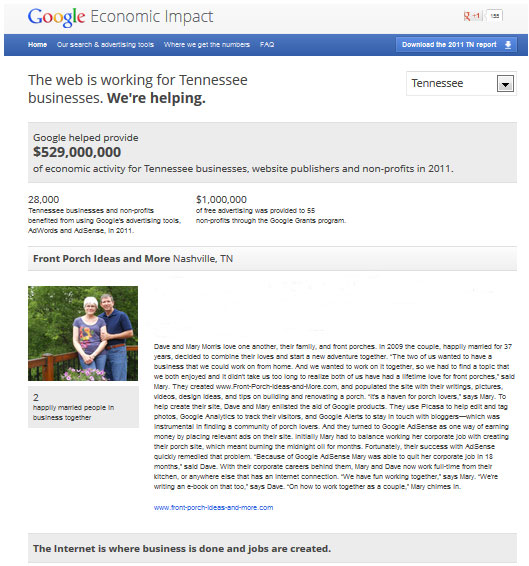
How did Mary and Dave get found and chosen by Google? By following SBI!’s core principles, such as “keep it real” and “OVERdeliver.” They created outstanding content in their unique voice, which grew both search and social traffic, and made them an authority in their niche. The beauty of this is that you don’t have to issue press releases. Hardly anyone from the press reads them anyway. But they all search for excellent sources when doing a story about your niche! Guess who gets found like clockwork? Yep, there are countless SBI! examples of this type of press success — here are a few more. Our two kitchen table entrepreneurs then used the initial spotlight from Google to boost their business’s publicity even further, as they explain below.
Then we used that promotion to help us be featured in our local newspaper, The Tennessean.
The Tennessean printed an awesome article about us on the front of their business section. That newspaper article was in turn seen by a Fox News reporter and she contacted us to see if their filming crew could come to our home and talk to us about being “Kitchen Table Entrepreneurs.”
The video Fox filmed was subsequently shown on National Fox News twice on a Saturday. We received nice responses from people all over the world and had a good spike in traffic from that.
8. Your topic lends itself well for referrals to local contractors. How do you facilitate and monetize these referrals?
The contractor referrals are one of the easiest ways to generate income each month. We host a form on our site from a third-party company that our readers fill out to get free estimates from local contractors.
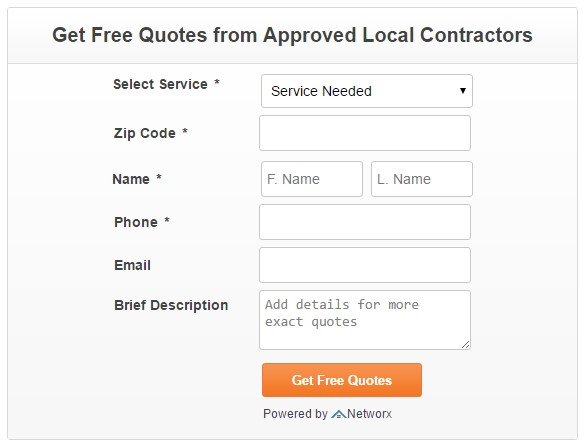
The best part for us is that it requires no work on our part except getting traffic to our site and we are pleased every month at the number of referrals we generate. We also love that it is providing a service to our readers, enabling them to find contractors who can help them build or remodel their porch.
We get paid a set amount for each referral depending upon the type of work the customer is seeking. In addition to that, we get company matching commissions. The only effort on our part is to submit an invoice to the company each month and we gladly do that through PayPal.
We have been helping solopreneurs for 20 years, 15 of them through Solo Build It!. It took us a while to realize it, but the most important thing that is included in SBI! is… ⏳TIME⏳ Every solopreneur is, by definition, time-limited. Every aspect of SBI! is about assuring that you invest every last second into the most meaningful business-building task. “No work except getting traffic?” Really? That’s the hardest part for most solopreneurs, especially the “stunning websites” that are advertised widely. Those BigCo’s forget to mention that the lights are off at most of those home pages – no one is visiting. Not so for Mary and Dave. They followed SBI!’s proven process to attract thousands of targeted visitors to their site per day. They PREsell them with information based on what they know are key areas. Then they refer those PRE-warmed visitors to contractors (who have no or low traffic websites) for a commission fee.
9. What has been your biggest challenge so far as a solopreneur couple?
We are very fortunate to work well together. Sometimes we have different opinions about which direction to take our business — but all in all that has helped us more than anything. The two of us are very different in the way we work and our strengths, but we use that to our advantage, to complement each other.
Dave is more big-picture and I am more the details. We are in tune with each other in terms of who handles what and many times our areas overlap. Sometimes we get overwhelmed with things to do and we are so glad there are two of us, but it doesn’t seem like enough at times.
Later, you become a victim of your own success. The more successful you are, the more there is to do! That’s when you have to make a key decision… Do you remain a solopreneur or do you hire great folks, enabling you to do what you do best and manage the big picture?
More than challenges, we see the advantages. We’ve had several occasions over the years where our presence was needed with family members. We picked up our laptops and went to be with our family, sometimes for weeks at a time. You just can’t do that with a normal “job.”
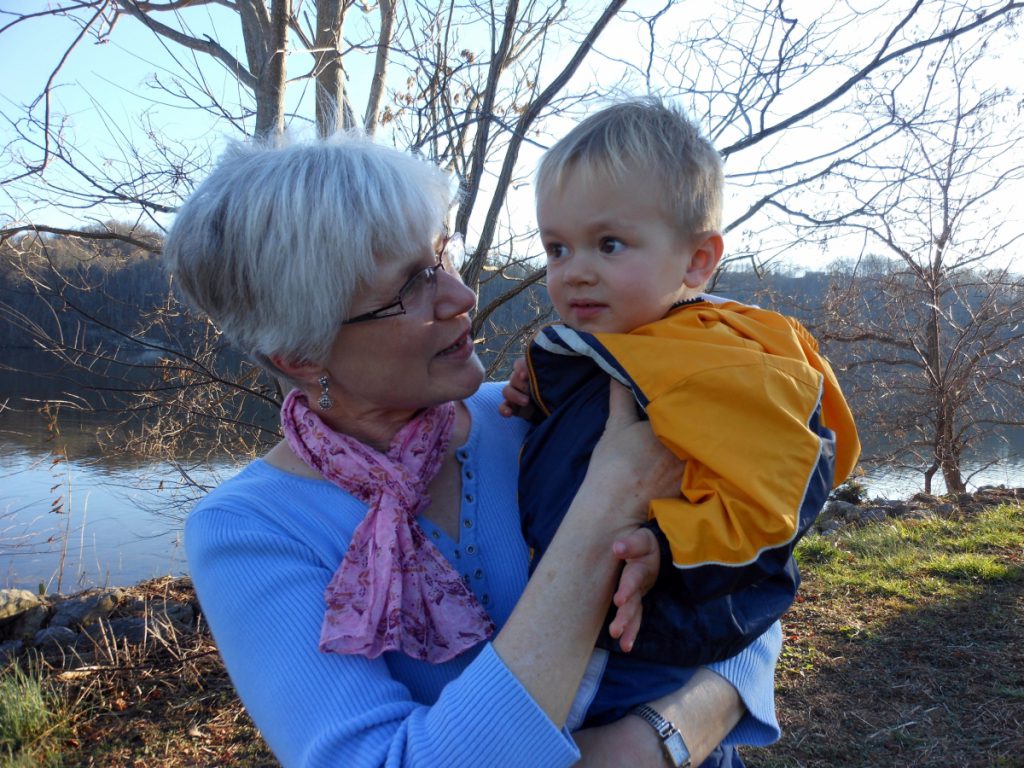
We love being a solopreneur couple, but we have seen ups and downs over the years for sure. With Google algorithms changing constantly and all the changes in the internet, it’s a rock and roll ride. At times, frustrating and disappointing, but we are proud we’ve held our own over the course of time.
Being a solopreneur couple requires dedication and a ton of consistent effort. We’ve put in countless hours.
One of the greatest advantages of having a successful online business is that it goes with you — wherever you need to be. And if life throws you a curveball, so what if you have to leave your business on auto-pilot for a while? It will carry on earning money until you’re ready to take up the reins again.
10. And finally… What do you enjoy most about being online business owners? How has it changed you, your life, your family?
To be honest, the best part for us is what we don’t have: no alarm clocks, no commutes, no bosses, no asking for vacation time, no appraisals, and no set hours. The freedom from those things is the very best. It has given the two of us a much more fun way to earn a living, one that we are excited about even after almost 9 years.
We also love that we don’t have any inventory, leases, employees or appointments. Being online is the best, as we can work from just about anywhere – from the beach, a hotel room, in the car, at our grandchildren’s home – you name it.
And we can be creative in our business – from shooting videos to creating graphics, building something neat for our porch, creating calendars, and taking thousands of fantastic porch pictures.
Our business has been an inspiration to our family and has enabled us to spend more time with them. They are also entrepreneurs and we love that. Having our own business has helped us appreciate what goes into a business and has allowed us to grow personally and do more of what we like.

We incorporate our hobbies into our business and that makes it fun for both of us. Dave and I have our “meetings” on our porch.
We appreciate that our business model is passive income. We earn income around the clock without having to show up at a particular time or meet a deadline. With that being said, our business still requires much effort and focus.
But the amazing part is that the content that we wrote years ago still generates income day after day.
Currently we are giving our site a new look and style — all while improving our existing pages and making our pages more responsive to different screen sizes. So we are in transition. It’s all part of the journey.
For anyone thinking of creating an information-based business like ours, we recommend you choose a niche you enjoy and realize that it will take work and consistent effort over time.
What a blessing! Never give up on what you want to do in life.
KEY TAKEAWAYS
- To find your perfect business niche start with a list of all the things that interest you or you are good at. Narrow the list down to your top 3. Then research each idea’s business potential with smart tools, like SBI!’s Brainstorm It!.
- Enhance your passive income streams with higher paying models like site sponsorship and referrals.
- You can’t be everywhere on social media; choose the best channels for your topic and audience.
- Celebrate your business milestones (like making your first cents or dollars)! It’s the fuel that will keep you going as a solopreneur.
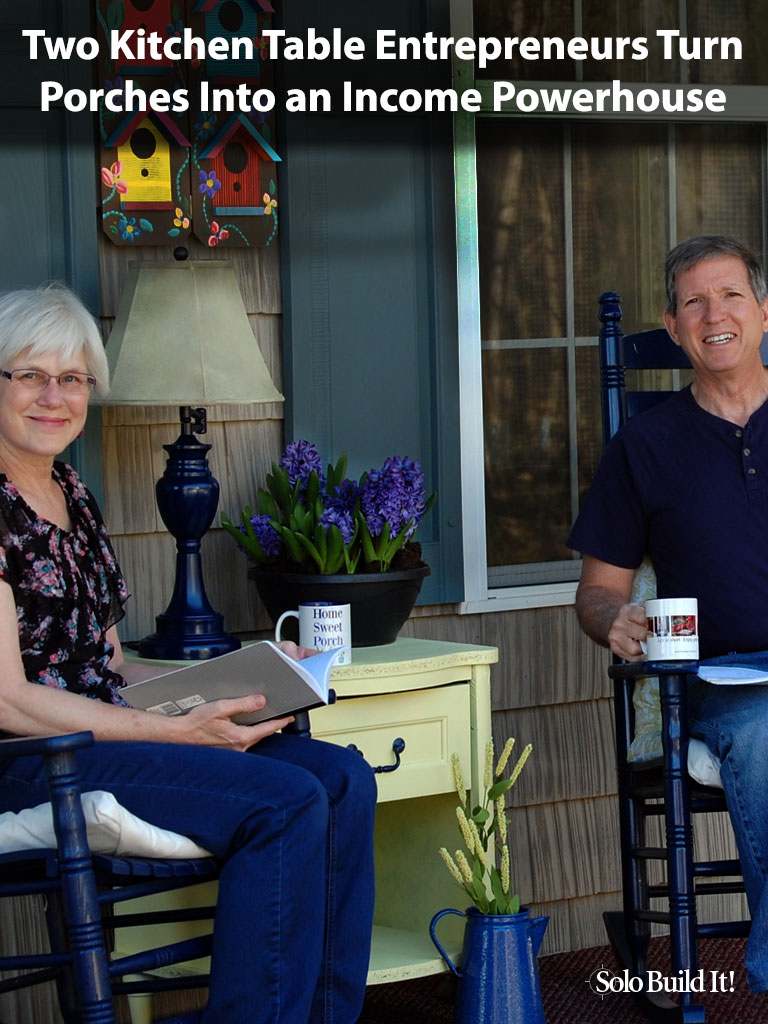
Latest posts by Margit Streifeneder (see all)
- From Zero to 1 Million Fans: A Community-Driven Success Story - October 16, 2025
- Six Figures on Her Terms: A Lifestyle Business Success Story - September 25, 2025
- From Sheds to Sales: A 20-Year Digital Product Success Story - September 11, 2025

